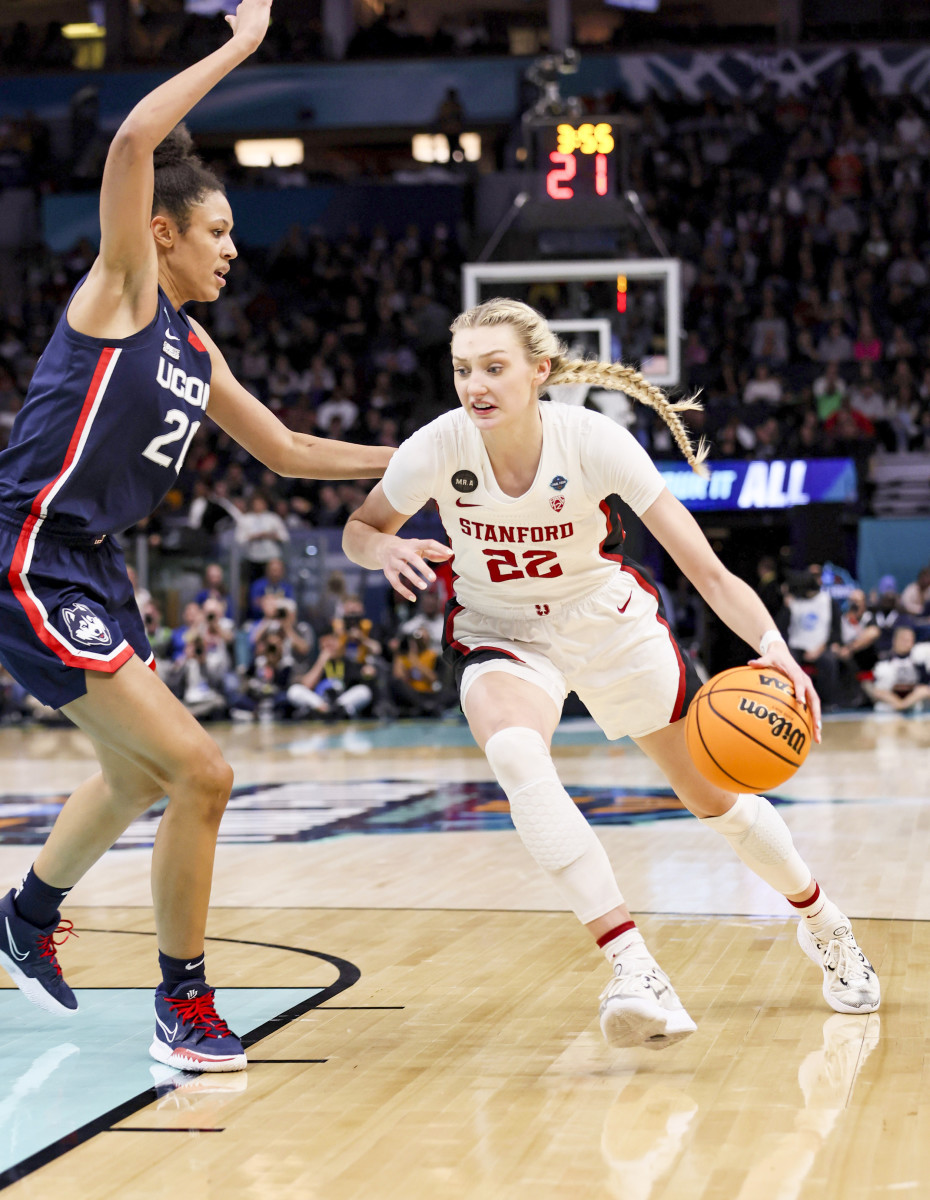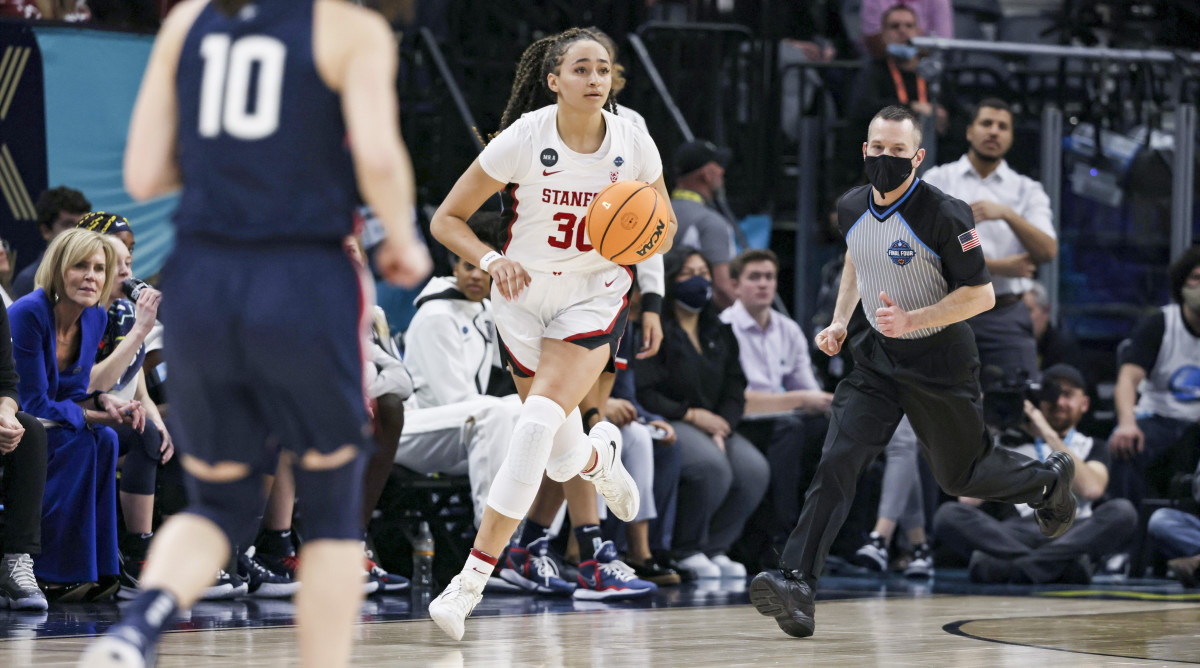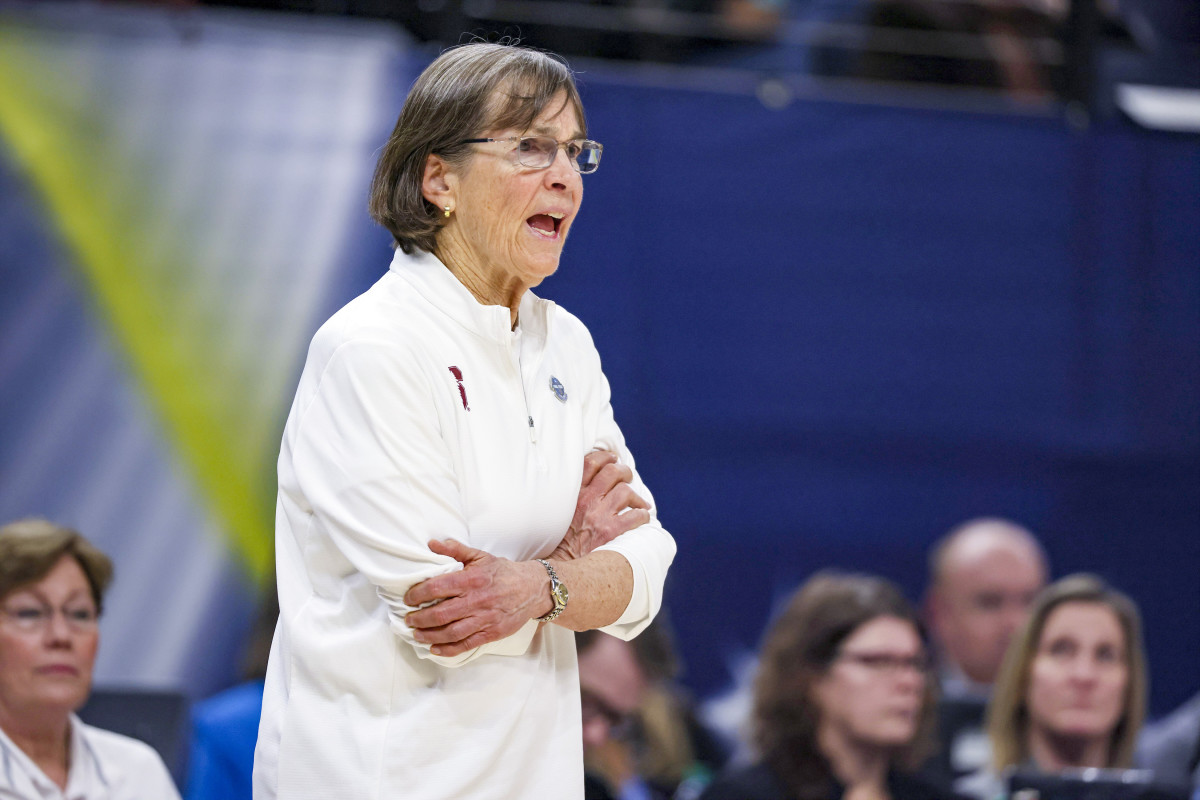With Eyes on a Final Four Return, Stanford Is Leaning Heavily on Its ‘Happiness Professor’
Stanford forward Cameron Brink looked on from the bench, having fouled out of her team’s February matchup against Oregon late in the fourth quarter. As she sat and watched the waning seconds of the contest, with then No. 2 Stanford clinging to a three-point lead, something clicked in her mind.
With 6.5 seconds to play, Agnes Emma-Nnopu went to the free throw line. The then sophomore guard would take only nine shots from the stripe all season and make just five of them. On this night, she missed the first. In between the pair, Brink and then teammate guard Alyssa Jerome called out from the sideline, “You’re loved, Agnes. We love you!”
“Just letting her know we’re behind you,” Brink says now. “It kinda just felt second nature.”
Emma-Nnopu took a deep breath and sank her second attempt, stretching Stanford’s lead to four. A few ticks later, the Cardinal basked in the elation of the victory that kept them in the mix for the Pac-12 title, a win that All-American Haley Jones says was a “make-or-break moment” for the group.

Brink and Jerome’s message was no coincidence. Every Tuesday, usually before the start of practice, coach Tara VanDerveer invited Frederic Luskin to speak with the team. Luskin is an educator, author and director of the Stanford Forgiveness Project, which researches the effectiveness of “forgiveness therapy.” With players gathered around him, Luskin would begin his 10-minute meditations with a guided visualization or breathing exercise, before raising that day’s central theme, usually pertaining to the qualities of grit or the power of love. He would conclude with another interactive component, like asking those in attendance to imagine what a successful practice would look like or think of someone on the team you were affectionate toward and feel the warmth in your heart.
Among the basketball situations he discussed most were high-pressure, late-game moments at the free throw line. “If you’re taking a free throw and you’re anxious about the outcome, remind yourself that you’re loved,” he often told them.
“Like a cool, full circle moment,” Brink, now a junior, says of Emma-Nnopu’s free throw.
Throughout last season, the Cardinal “soaked up every minute we could get” with Luskin, says Brink, who playfully calls him “Stanford’s happiness professor.” VanDerveer believes he has been helpful to the program. This season, time will be invaluable for the Cardinal, who are undefeated through their first five games and still hold the No. 2 spot in the rankings. Returning players are especially cognizant of making the most of every second and every game.
Over the course of one subpar outing against UConn in the national semifinals this past April, Jones, now a senior, went from a player who had never lost an NCAA tournament contest—March Madness was canceled during her freshman season, and Stanford won the tourney during Jones’s sophomore campaign—to one who likely has one collegiate run left. Weeks before that, the team and university had been reminded of life’s fragility when Stanford soccer goalie Katie Meyer died by suicide. Luskin was among the people who helped the players process initial feelings of grief.
VanDerveer sees this year’s team “as a totally different puzzle to put together,” due in part to the departures of starting guards Lexie and Lacie Hull and Anna Wilson, as well as reserves Jordan Hamilton, Jenna Brown and Jana Van Gytenbeek (the latter two via the transfer portal). Nevertheless, expectations remain high. “As a team, we have the same goals every year,” Jones says. “It’s an undefeated regular season. Win the Pac-12 regular season. Win the Pac-12 title. Win the regional. Win the natty.” Sure, those are lofty aspirations—especially with No. 1 South Carolina coming to town Sunday—but they are also not unreasonable considering the school’s talented roster and recent history.
It’s impossible to exactly quantify how much Luskin helps Jones, Brink or any one teammate on any given possession. VanDerveer is a traditionally intense coach but says she has recognized in recent years the importance of finding new ways to reach her players. Luskin helps keep the team centered, says the coach, and fosters feelings of togetherness, which can pay dividends on the hardwood. Stanford’s returners have had time to apply Luskin’s teachings to an adverse situation, like their abrupt tournament exit against the Huskies and significant roster turnover, and think about their response. “We do everything with joy because we all love what we’re doing and we love each other,” Jones says.
The Cardinal are hoping the most euphoric of celebrations awaits.
Last April, a few hours before Stanford took the Target Center floor for its Final Four matchup against UConn, Cardinal players were greeted with a pleasant surprise. With the group gathered in a hotel conference room to watch film, Luskin popped up on their projector screen. Players initially complimented Luskin on his haircut, and then he gave the Cardinal a parting message: Not for a second believe that you have failed even if you lose the next game. Acknowledge success and try and extend it, rather than being afraid of failure.
Try as they might, though, Stanford struggled to crack the Huskies’ defense. The Cardinal scored only nine first-quarter points and eventually totaled just 58, their second-lowest output since Nov. 26. Brink, having watched the contest again three times, cited the team’s shooting woes—Stanford finished 34.8% from the field and 17.4% from three-point range.
“I think we kinda just picked the wrong day to play so poorly,” VanDerveer says. “We were out of sync. We did not have our A game.”
In the locker room afterward, the focus of the Cardinal was on their five seniors. The veterans had been instrumental in Stanford’s title run the year before, creating a fun-loving and mentally tough atmosphere while the team spent nearly 100 nights on the road (Santa Clara County’s COVID-19 restrictions forced the team into a nomadic lifestyle). Throughout the 2021–22 season, the quintet anchored a group that bonded through shared time on the court and by seeking out local coffee shops, performing TikTok dances and creating their own Wordle games on a whiteboard in the locker room—thinking of a five-letter word and then others guessing different combinations.
“We genuinely enjoy each other’s company; we’re kind of friends first, teammates second,” Jones said last winter.
Players went around to one another’s lockers and exchanged lengthy embraces. Brink estimates there were 10 minutes of silence before some of the seniors spoke to the team or coaches shared their wrap-up comments.
“That was a time where it could have been like, ‘Wow, eff everything Fred said. None of that meant anything to me. It was all a show,’” Jones says. “In the locker room, it was full of sadness, but I think it was sadness that was more than a basketball season ending. It was a sadness that was more so centered around that group of girls. That was an end of an era.”

Stanford’s senior class already has a nickname. They call themselves “The Funky Four.” Guard Hannah Jump and forwards Fran Belibi and Ashten Prechtel are the first three in the group, followed by Jones, the lone returning captain from last season.
Despite her parents being former co-head coaches for the Santa Cruz High girls basketball program, Jones was a multisport athlete. Throughout her youth, in addition to playing hoops, she dabbled in soccer, volleyball, gymnastics, golf and swimming. That’s part of why Haley and her parents see basketball as something she does—and loves—but not exclusively who she is.
Her father, Patrick, says Haley was an inviting presence, no matter the activity. He recalls her always looking to include teammates as much as possible in drills and organizing games at school. She has been the same way at Stanford.
Jones seldom raises her voice. Her family instilled in her a motto: Calm is strength. And through three full collegiate seasons, VanDerveer says Jones has “never really” shown frustration.
The 2021 Final Four Most Outstanding Player brushes off any notions of feeling pressure for her senior campaign. “I think it’s more excitement [than nerves],” Jones says. Part of that anticipation comes from moving to a new role—previously more of a wing and forward, Jones is now tasked as Stanford’s lead ballhandler.
To prepare, Jones spent the offseason working on her dribbling and perimeter shooting. She trained with skills coach Packie Turner, who has helped other high-profile court creators like Stephen Curry and Sabrina Ionescu. VanDerveer tosses out other guards, like Aces star Chelsea Gray and former U.S. Olympian Teresa Edwards, as possible models for Jones’s game. “She’s kinda the Magic Johnson–type point guard,” VanDerveer says. “A big, strong, physical player that can go to the basket.”
Jones continues to foster individual relationships with each of her teammates, seeking to understand everyone’s styles and how they like to receive feedback. “When you’re playing with people that you love, you’re gonna want to work that much harder for them,” she says—her comments echoing sentiments voiced by Luskin. She also hopes to build a level of trust with her peers so that “if I need to yell at them, they’ll be able to take it and know, She wants what’s best for me, she loves me and this is for the betterment of the team.”
Around a half decade ago, VanDerveer sat in on a guest-speaker session with the university’s athletics department. The speaker was Luskin, who taught a course on campus called The Art and Science of Happiness. His lecture to the staff focused on the intersection of emotions and sports, and how stress and negativity adversely impact performance. “The normal sport psychology talk,” he says, “but with a decided push toward happiness and what makes people happy.” The key: “relationships and purpose.” VanDerveer was inspired, and soon afterward invited Luskin to speak to her team.
Initially, Luskin’s sessions with the Cardinal were more sporadic, but they have become more regular due to his limited travel amid the COVID-19 pandemic. VanDerveer and Luskin are aligned on their beliefs, and the coach says hearing the same message from another voice can be beneficial. “I think he really grew on everyone,” VanDerveer says. “I felt he motivated [the team].”

Luskin’s teachings have been especially resonant with Brink, who has “I love you” in American Sign Language tattooed on her right rib cage. She cites his Zoom meetings as being helpful in reframing the feelings of homesickness and isolation she felt as a freshman. Last season, she drew on his messages about thankfulness for others and about avoiding labeling people. When Stanford lost to UConn in the Final Four, past conversations about not blaming oneself, or teammates, in the wake of struggles rang clear.
“His teachings are so simple, yet so profound,” she says.
Brink is trying to apply those messages to how she treats the team’s freshmen, especially 6' 7" center Lauren Betts, who was rated as ESPN HoopGurlz’s No. 1 recruit. When Betts performs well in sessions, Brink looks her in the eyes and says, “You’re f------ killing it. Keep doing that. You’re great.” Brink also invested in her own growth. She emphasized her mental development—she says she still sometimes gets anxious before games and second-guesses herself, so she tries to focus on what she is good at to balance her nerves. “I’m good at bringing energy, at recognizing how I feel when I’m in flow.” She spent time with various strength trainers and skills coaches to diversify her game and also worked out with six-time NBA All-Star Pau Gasol, who helped her with her footwork and post moves. “It was the biggest compliment, because he’d tell me a lot, ‘You’re a bit like me,’” she says. “‘You’re not going to win by just bully ball. You’re going to win by outsmarting people.’”
Players like Brink and Betts will help keep Stanford at the top of the national conversation beyond this year, but the focus now is on the short term and creating a shared purpose. Luskin will continue to engage in weekly meetings with the team and coaches. He plans on occasionally referencing Phil Jackson’s 11 principles of mindful leadership. Many are similar to things Luskin has offered in the past, but he believes connecting his work with the Hall of Fame coach will give “an intellectual basketball anchor.”
Stanford has one of the country’s most daunting schedules, with nonconference home matchups against South Carolina and Tennessee. Brink’s theory is VanDerveer made the schedule difficult “to make us band together.” A national title would no doubt be satisfying, but Brink makes clear the team shouldn’t be defined by it.
“You’re so much more than just what you do on the day-to-day,” she says. “Everyone else around you is human. And the more you create this environment of love and acceptance and tolerance, the better everyone will thrive.”
More College Basketball Coverage:
• Kansas’s ‘Championship DNA’ Prevails Over New-Look Duke
• Daily Cover: The Full Drew Timme Experience
• How Kellie Harper’s Past As a Player Is Shaping the Vols’ Future
